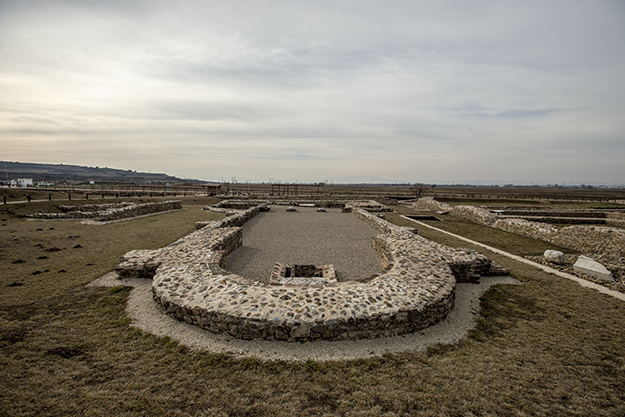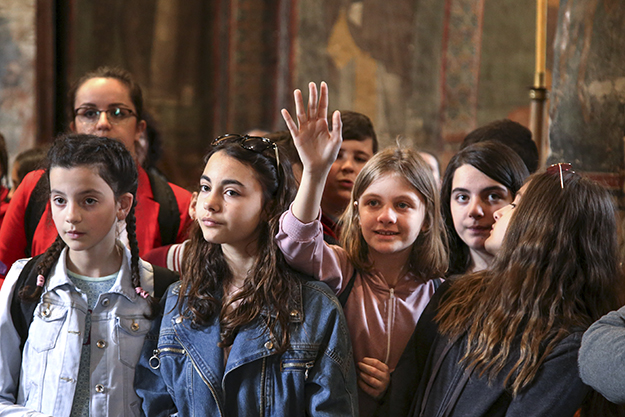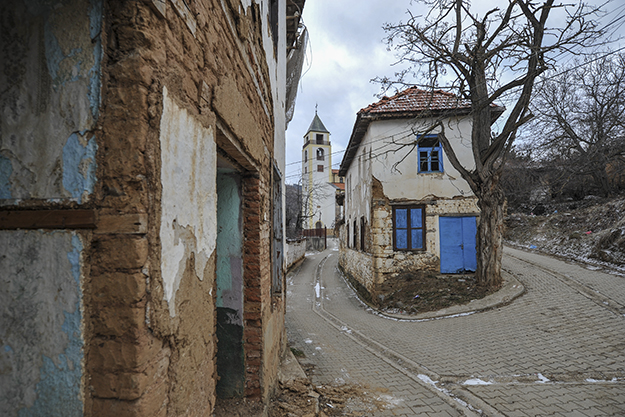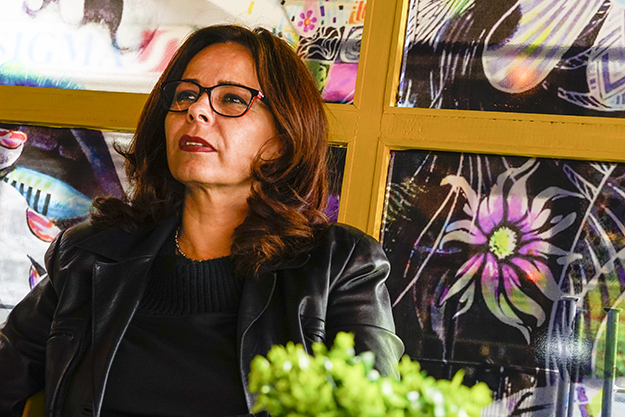The idea is simple.
Little Anita would go with her father, on one of the most casual summer Sunday mornings, on a thrilling cultural heritage adventure. After a drive of about 30 minutes from Prishtina, they would arrive in the ancient Roman city of Ulpiana.
Equipped with VR goggles, they would join another group of tourists, let’s say German, and follow the guide. Depending on the data, which would be provided by archaeologists, they would experience the ancient city as it was in the fourth or sixth century and, who knows, maybe see some projections of the very original citizens and soldiers going about their duties.
Not only little Anita, but surely most little humans in this world wouldn’t be able to get enough of such things.

The Roman city of Ulpiana, not far from Prishtina, has undergone recent restoration work, but ideas for bringing the site alive to the next generation are still a pipedream. Photo: Atdhe Mulla / K2.0.
But as reality stands now, the most likely occurrence would be that the gates of Ulpiana would open upon your arrival and, if you are lucky that day, you might get someone to show you around. No VR goggles, no German tourists — and hardly a thrilling adventure.
Sali Shoshi, the executive director of Cultural Heritage Without Borders (CHWB), which has been helping with conservation and education work at the site, says that they want to embark on such an experiment, but whether they will succeed or not he seems a bit unsure.
Nonetheless, he is convinced that school lessons at all stages of education, as well as excursions, should change when it comes to exploring and understanding the legacy of the past.

Cultural Heritage Without Borders’ Sali Shoshi says that little has changed in Kosovo’s approach to cultural heritage in the past half-century. Photo: Valmir Mehmetaj / K2.0.
Surely, he feels, there is more to cultural heritage than dull-voiced lectures and visiting the League of Prizren or former KLA Commander Adem Jashari’s house.
“Cultural heritage can become a resource for reconciliation, coexistence, a catalyst to accept change; it can also be an economic development factor,” he says. “It’s a resource to think about as a [potential future] career, an element that nobody really discusses.”
But according to Shoshi, little has changed in the last 50 years in the approach to Kosovo’s cultural heritage.
“I once visited the Museum of Kosovo with a bunch of preschool children — my son was one of them,” he says. “And I remember the guide telling them, ‘This is an artefact from the fourth century Before Christ…’ — as if a child knows what such things are!”
“We don’t have such places where children are participants and are actively involved in learning history."
Sali Shoshi, Cultural Heritage Without Borders
Nowadays it’s easy to learn about Achilles from Hollywood, or to learn about Joan of Arc or Illyrians as tribes in computer games such as “Civilization” or “Age of Empires.” And many more opportunities abound, from teaching children about cultural heritage through plays, performances, games and other interactive and engaging methods.
“I’ve seen many museums in the West where whole classes of children go there and just draw artifacts, through their own interpretation,” Shoshi says. “Or they go and carry out performances.”
In one such visit, he recalls seeing the whole setup; children in the ancient little soldier costumes, toy swords, and bows and arrows.
“Ulpiana is the perfect spot to make such classical performances, where you could even try to bring back this kind of antiquity theater,” he says. “We don’t have such places where children are participants and are actively involved in learning history. You cannot study about Illyrians or Romans in fifth or sixth class without having the opportunity to experience it.”
Livening up lessons
It’s not only those responsible for the cultural heritage sites themselves that need to rethink the way they engage visitors, but there is also a clear intersection with the way in which cultural heritage is treated by schools.
It seems that Kosovo’s schools, by institutional design, are not yet adept to competently transmit cultural heritage values to pupils.
In school curricula, cultural heritage does not exist as a separate entity, but is taught within three other subjects, history, geography and civic education.
How such topics are taught by teachers — who are ultimately individuals with their own ideas, methods and sense of professionalism — varies from one to another. But in a much maligned sector with its multitude of challenges, one does not have to stretch their imagination too far to assume that in many instances it is the same old same old — teachers lecture, and pupils daydream.

There appears to be an appetite amongst Kosovo’s children for interactive and engaging cultural heritage work but the infrastructure and prioritization is lacking. Photo: Courtesy of Cultural Heritage Without Borders.
Supije Zhitija, director of the Gjergj Fishta elementary school in Prishtina, accepts that, upon reflection, cultural heritage has its values. The reason for schools generally not giving it any special attention, she thinks, might be because other priorities have been pushed harder, and in the end it is the loudest voice that wins.
“We ought to be honest that cultural heritage is a bit left behind because there have been lots of other priorities, and often it just comes down to who is most insistent,” Zhitija says. “But we would greatly benefit from emphasizing cultural heritage, because there are many things connected in there, from clothing, tradition, etc., and if we ask for [participational work] from the children they can surprise you every time.”
The sense that children in Kosovo have an appetite for such participatory learning is reinforced by CHWB program manager for culture Alban Morina, who has been involved in various cultural heritage projects with children and students from different backgrounds.
“From the indicators that we have received while working with new generations, we have seen that they are quite sensibilized and furthermore they are very willing to participate in cultural heritage work,” Morina says. “Only the infrastructure needs to be developed, so the [sites in the field] are ready to involve the youth in cultural heritage.”
Know thyself
In a passive way, in an indirect way, we are constantly coexisting with cultural heritage, whether tangible assets such as monuments, landscapes or artifacts, or intangible culture such as folklore, music and other traditions.
Artan Krasniqi, a culture journalist from Koha Ditore who has gathered his writings on the topic into a six volume book called “Monuments,” says that society’s connection to cultural heritage is multi-dimensional.
“First is an emotional connection, because people have memories about objects, about their history, that are transmitted from generation to generation,” he says. “Many cultural heritage monuments are even nowadays functional, which means that they also have a functional connection.”
In other words, Kosovo needs to spend a bit of quality time getting to know itself in order to show its full potential off to the rest of the world.
People still pray in 500-year-old mosques and churches, or live in kullas — stone tower houses — almost equally as aged, therefore he feels that people understand that historical, architectural, and cultural connection. Nonetheless, he feels that there is still a mountain of work to be done regarding cultural heritage.
“It is fundamental for any society to know itself,” Krasniqi says. “We have examples of our neighbors who do not have cultural heritage and desperately try to create something from crumbs of history to show as their cultural heritage. Whereas we, frankly, have it but do not appreciate it enough.”
In other words, Kosovo needs to spend a bit of quality time getting to know itself in order to show its full potential off to the rest of the world. In this way, the country might just attract more than the occasional passing tourist and could plant itself firmly on the Balkan tourist map, from which, Krasniqi suggests, it is conspicuously missing.
“It’s not the tourists’ fault; we did not do enough to call them into Kosovo, and to keep them afterwards,” Krasniqi says. “If it is not some tax evasion trick [by hospitality businesses] then, according to the Kosovo Agency of Statistics, more than half of the tourists in Kosovo do not stay longer than two days.”
Another issue seems to be that while at least those working in the field have grasped the significance of cultural heritage, there has been little genuine effort to make it relatable to the different communities living in Kosovo. Both Krasniqi and CHWB’s Shoshi agree that more needs to be done to include all of Kosovo’s communities and also to learn about cultural heritage as a point of commonality, rather than one of divisions.
“The cultural heritage of Kosovo does not belong to Albanians and neither do Orthodox churches belong to Serbs."
Artan Krasniqi, culture journalist
After all, Krasniqi says that we should not brag about which monument or spiritual heritage is “ours” and which is “theirs” for a simple reason:
“The cultural heritage of Kosovo does not belong to Albanians and neither do Orthodox churches belong to Serbs, because if we talk about [the prehistoric settlement of] Vlashnje, there were no Albanians and there were no Serbs. During the times when the Patriarchate of Peja or the Graçanica Monastery were built there were no Serbs, only Orthodox people. Albanian predecessors were Orthodox and Serb predecessors were Orthodox.”
According to Shoshi, this is a sensitive topic around which we ought to tread lightly. In particular, he feels, we should be careful as to what we teach our children because he sure does not want his child to grow up feeling the same resentment as his generation; there is no need for it, the war is over.
“History can not be hidden,” he says. “But nonetheless, we should find a way to talk about it that reflects toward the future.”
Instead of being a point of contention, he says that it can be a point of reconciliation, a reason more for living together and a point of appreciation for the diverse past of Kosovo’s cultural heritage.
Heritage for the future
In order to be able to move to such conversations, however, another conundrum first needs to be solved: How best to ensure and encourage public access to cultural heritage, while at the same time responsibly conserving it?
To date, there has been very little effort to connect cultural heritage with economic development, with the two widely viewed as separate spheres that are worlds apart. Rather than cultural heritage being actively used as an opportunity to provide local, sustainable jobs, it is more often than not treated as a “cost” to the public purse and a fiscal burden to some of Europe’s poorest citizens.
In the 2019 budget, the Ministry of Culture, Youth and Sport allocated over 6 million euros to Kosovo’s cultural heritage — more than half of which was allocated for capital expenditure — but that figure is forecast to drop in the coming years. Other sources of funding also currently come from the EU and other foreign funds, as well as from municipal departments of culture.
“We need to create an organized approach, not one that requires finding a map or just heading into a location without knowing for certainty where a monument is."
Dr. Florina Jerliu, from the University of Prishtina’s Faculty of Civil Engineering and Architecture, does a lot of cultural heritage work with students, from documentation to restoration and conservation, and feels that not enough importance is given to the economic aspect of cultural heritage. She says that there is a pervasive trend to remake all monuments into some sort of museum, which usually end up staying empty, whereas there should be greater efforts to make cultural heritage more self-sufficient.
To illustrate her philosophy, she points to an example of a project the Faculty undertook last year in Janjeva, with support from the Ministry of Culture, in which the whole year group went and renovated around 15 houses that were abandoned and half crumbling.
“We went again the next semester to do the restoration part, and we managed to create an idea as to what the economic incentive for them would be, because you cannot make them into museums,” she says. “So we made these kind of percentage [estimations], as to what could be turned into bed and breakfasts, what could be some small brewery or bakery and what income they would generate.”

The village of Janjeva, in Lipjan, is thought to date back to the early 14th century and has been the subject of a number of restoration projects in recent years. Photo: Atdhe Mulla / K2.0.
From her experience in the field, such as in the ancient city of Ulpiana where she participated in recent restoration and conservation work, it is vital to follow up such intervention work with efforts to increase visitor numbers and access opportunities to such sites.
“We need to create an organized approach, not one that requires finding a map or just heading into a location without knowing for certainty where a monument is because there are no signs whatsoever,” she says. “It might seem insignificant, but it has two effects. The effect of direction guiding you to see something [and allowing you to do so] in accordance with a set itinerary.”
Jerliu believes the next logical step would be to follow the example of the Ministry of Agriculture, which subsidizes small scale farming initiatives. Why shouldn’t the Ministry of Culture do the same for small local initiatives? asks Jerliu, giving an example of a small “house of fli.”
Such an initiative would see a small subsidy for a bakery that would make only “flija,” a national food popular amongst locals and visitors alike; one can often hear indulgers complaining about balloon bellies, drinking a river of water, and having a restless night after eating it, but they tend to add that they “would eat it again” because, it seems, sometimes the reward trumps the consequences.

Architecture professor Dr. Florina Jerliu believes that more should be done to link cultural heritage with economic development opportunities. Photo: Valmir Mehmetaj / K2.0.
Jerliu, just like Shoshi and the other field experts, all claim that cultural heritage can generate a wealth of jobs, from bus drivers, tour guides, beer sellers and hospitality to architects and archaeologists, as well as other welcome economic chain effects of tourism and small businesses. Yet there is palpable frustration that when plans are drawn up on “economic development,” such potential opportunities seem to be overlooked, forgotten or simply not understood.
“Take, for example, a city like Prishtina where for 20 years now the idea of development was that it was not important to conserve the historic zone because we should prioritize development,” says Jerliu, referring to the relentless construction that has taken place since the war. “They fail to realize that the perspective of development can very well happen through touristic economization of the historical zone. They separate these things.”
Currently, elements integral to cultural heritage are divided between many institutions — such as the Ministry of Culture, Youth and Sport, the Ministry of Environment and Spatial Planning, the Ministry of Trade and Industry, the Ministry of Economic Development and different departments within municipalities — with little effective coordination between them, Jerliu says.
Politicians and their latest agendas are temporary and movable feasts. Cultural heritage, by its very definition, has longevity.
Recently, the architecture professor formed part of a team of experts and government officials to compile Kosovo’s National Strategy for Cultural Heritage 2017-2027, which is full of good intentions on prioritizing the “sustainability” and “socio-cultural, economic values” of Kosovo’s cultural heritage. But strategies, however well intentioned, are somewhat meaningless without effective implementation.
It’s still relatively early days in that 10-year plan, but the signals to date, Jerliu suggests, is that it remains predominantly on paper.
Recent history shows also that cultural heritage receives an attention boost in Kosovo when the latest UNESCO membership bid is on the cards and gets somewhat sidelined in between — as if it has importance only when the politics of the day says so.
But politicians and their latest agendas are temporary and movable feasts. Cultural heritage, by its very definition, has longevity, values and is passed on from generation to generation.
And if today’s generation are just guardians, keeping watch over the treasure, we must also ensure that this heritage is accessed, interacted with and is made meaningful so that little Anita’s great grandchildren — and their great grandchildren after that — can also have a shot at understanding who they are.K
Feature image: Majlinda Hoxha / K2.0.

Back to monograph







